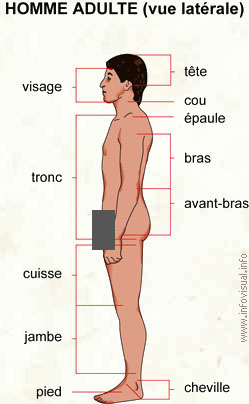Homme adulte (vue latérale)

Tête: Partie supérieure du corps comprenant le visage et le crâne.
Cou: Partie du corps comprise entre le tronc et la tête.
Épaule: Articulation joignant le bras au tronc.
Bras: Partie du membre supérieur comprise entre le coude et l'épaule.
Avant-bras: Partie du membre supérieur comprise entre le poignet et le coude.
Cheville: Articulation joignant la jambe au pied.
Pied: Partie du membre inférieur de l'homme supportant son corps en position debout.
Jambe: Bas du membre inférieur de l'homme.
Cuisse: Haut du membre inférieur de l'homme contenant le fémur.
Tronc: Partie centrale du corps.
Visage: Partie antérieure de la tête de l'être humain.
Photo :

Domestic goats are one of the oldest domesticated species. For thousands of years, goats have been used for their milk, meat, hair, and skins all over the world. Most goats naturally have two horns, of various shapes and sizes depending on the breed. While horns are a predominantly male feature, some breeds of goats have horned females. Polled (hornless goats) are not uncommon and there have been incidents of polycerate goats (having as many as eight horns), although this is a genetic rarity thought to be inherited. Their horns are made of living bone surrounded by keratin and other proteins and are used for defense, dominance, and territoriality.
Goats are ruminants. They have a four-chambered stomach consisting of the rumen, the reticulum, the omasum, and the abomasum. Goats have horizontal slit-shaped pupils, an adaptation which increases peripheral depth perception. Because goats' irises are usually pale, the pupils are much more visible than in animals with horizontal pupils but very dark irises, such as sheep, cattle and most horses.
Both male and female goats have beards, and many types of goats may have wattles, one dangling from each side of the neck. Some breeds of sheep and goats appear superficially similar, but goat tails are short and point up, whereas sheep tails hang down and are usually longer, though some are short, and some long ones are docked.